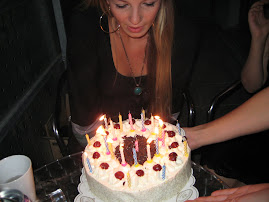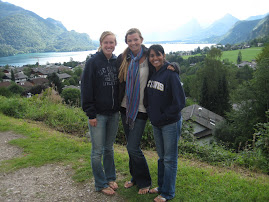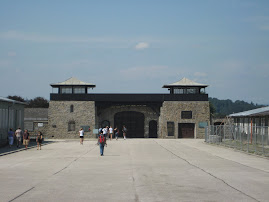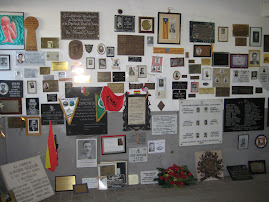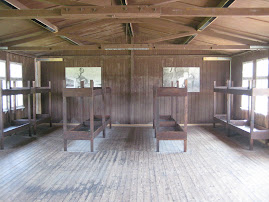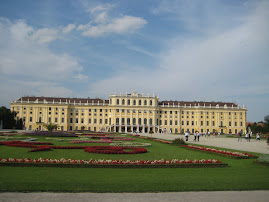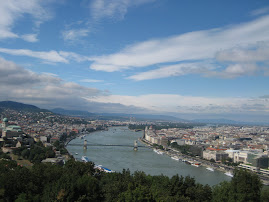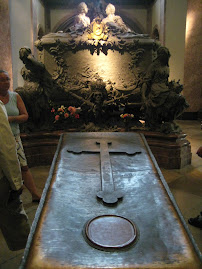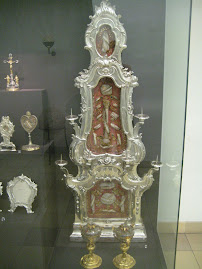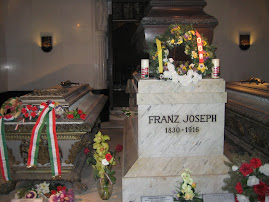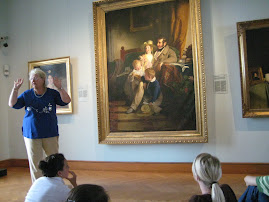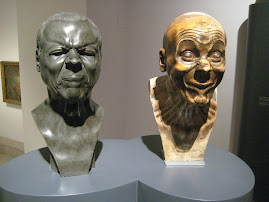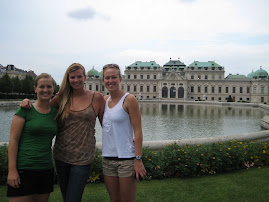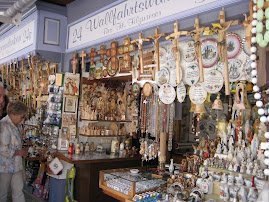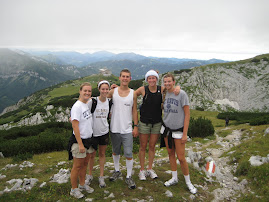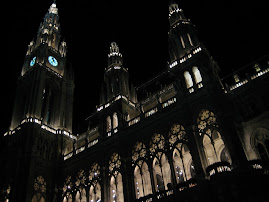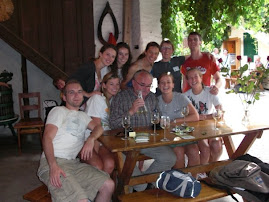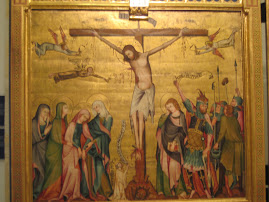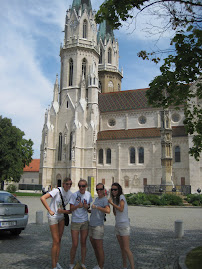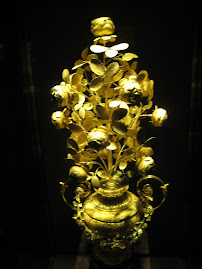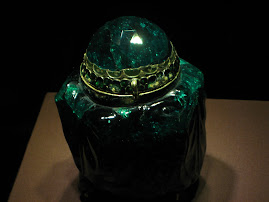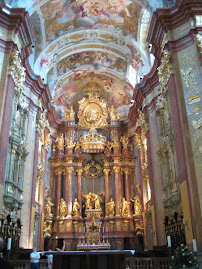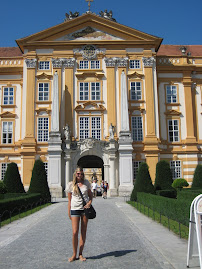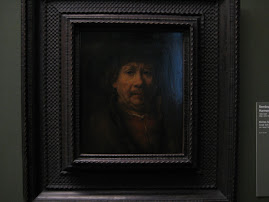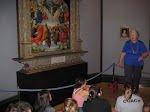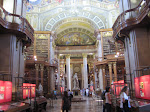On Friday, August 29th, I turned 22! When I woke up a group of friends and I went out for a traditional American-style breakfast (none of this espresso and croissant business.) We found a restaraunt that serves breakfast all day long, offering scrambled eggs, omelets, french toast, and waffles on the menu. Since breakfast is my favorite meal of the day but the Viennese seem not so enthusiastic about it, I was excited to eat a nice big, proper breakfast! Afterwards, we headed over to Kahlenberg which is in the Vienna woods, near the foothills where the wine country is located. It took us about 30 minutes to get out there through public transportation, which took us out to the beautiful suburbs of Vienna filled with large houses and tree-lined streets. Once we got there we walked along the windy roads through the various vineyards, in search of wine gardens. We stumbled across several, and enjoyed lovely, locally grown wine while overlooking the entire city of Vienna, high up in the hills. Around three pm we headed back to the apartments to get ready for a fun night out. After resting and getting ready we all congregated in one room while preparing to go out. All of a sudden, a few people came out with a cake covered in lit candles, while singing me "Happy Birthday". Eventually we left the apartments and headed to a really cute Spanish restaraunt where we got a large table and ordered food and drinks. The restaraunt is near the Museums Quartier- right across the street from a local Beer garden (the one that serves hemp beer). After spending some time at the restaraunt, we headed across the street for some beer, and later on in the night finally headed home. I had a really fun birthday, and even though I've only known the people in this program for several weeks, I was blown away that everyone went out of their way to make my birthday fun and special.
The next day was our last day in Vienna. I spent most of the day cleaning, organizing, and working on blogs. Around 4 pm I left for the Prater which is the Viennese amusement park that has been around for over a century, and is a prominent aspect of Vienna for locals and tourists allike. We rode the Ferris Wheel as a class, and I enjoyed this final act of closure as we gazed out over the entire city and laughed about all the good times we enjoyed over the past month. After the ferris wheel, the entire class headed over to the downtown area where we ate at a fun, local restaraunt with traditional Austrian food. We shared even more laughs and stories, and it was overall a really fun, final night in Vienna. I headed home to get ready for the next day's travel by packing and getting a good night sleep.
Overall,I thoroughly enjoyed my study abroad experience in Vienna. I thought some highlights were the class field trips such as to the alps, and all the museums. To be honest, I was dissapointed that our class was cut short and we only got as far as the beginning of World War II in our historical studies. I am really intersted in the time period between the french revolution through the 21st century, and I was bummed out that we only got as far as the beginning of the 1940's, as a class. I am really glad that I chose this program, and I want to thank Kathy for a wonderful experience.
Wednesday, September 10, 2008
Leopold Museum
On August 28th- our last official day of class, we met at the Leopold Museum for our final Dr. O tour. I was sad because Dr. O is so entertaining and I love learning about art history through her animated lectures and story telling. The museum was built specifically for the collection that Dr. Leopold and his wife had accumulated over the years, which filled up three stories worth of art. He started collecting in the 50's when prices of paintings were fairly lower in the post-war years. Dr. Leopold aimed to create a modern museum where young people can be exposed to great art. He even resorted to edgy marketing and the museum has a modern feel to it. We first looked at the Gustav Klimt exhibit, where Dr. O gave us some detailed information on his life and art. She explained that he lived with his lover and friend Emilie Fluger who was also an edgy fashion designer. She was Klimt's "muse" and one of the many woman that contributed to his fascination with the feminine mystique. After he retreated from the 'Academic Style' of the Ringstrausse when his ceiling paintings were rejected by the University, he began doing portraits of wealthy aristocrats, then broke off further and entered his 'gold' phase. The paintings of Law, Medicine, and Philosophy that he created for the University won first prize at a Paris art show after being rejected by the more conservative Vienna. One Klimt that we looked at closely was called "Death and Life." There is a figure of death on the left hand side which is a dark, shadowy, skeletal figure that came through to me as sneaky, playful, curious, and even envious of the lively, colorful, living people on the right who were intertwined in a mess of colors and purity. In the group on the right there are women at the top, a peaceful baby, and girls floating on the side (that were added 5 years later and have a sloppier look to them.) There is an older woman and two lovers who appear to be aware of death, as if it is somehow close to them. The left row of figures who were added years later appear to be different because they are looking at the audience- therefore drawing us into the painting.
The next artist we looked at was Koloman Moser- who made furniture, stained glass, and helped design the church of an isane asylum. Moser created my favorite work of art in the entire museum which immediately caught my eye: "Looking Towards the Rax." This painting was inspired by the alps which weeks before, I was deep in the heart of. We didn't even talk about this painting as a class, or even acknowledge it, but it moved me more than any painting Dr. O showed us that day in the Leopold Museum. There are incredibly vibrant, deep blues and greens which depict alpine trees in the foreground and the ominous alps in the background. We didn't even go over this painting or so much as hesitate to look at it, yet it was one of my favorite paintings i saw in the entire museum.
The next artist we focused on was Egon Scheile (1890-1918). This artist witnessed his father with syphallus who refused all medication and died a slow, painful death. Because of this experience, Scheile became obsessed with death and decay as a painful yet realistic aspect of life. Scheile went to art school but was kicked out for painting rude, explicit, even pornographic images- and he never graduated. Klimt became his mentor right around 1907, yet he was completely overtaken by his own life and the experiences that scarred him. Scheile painted many images of "the blind mother" when his own mother was metaphorically blinded by his own hopes, wishes, and dreams of artistic fame. "The Cardinal and the Nun" was one painting by Scheile that was inspired by "the Kiss" yet entirely different. The painting is of a woman and man kneeling, embracing one another, yet they look guilty as if they have just been caught in the act of passion. The painting is filled with dark colors which represent a red cloak from the cardinal and the black outfit of the nun. If you seperate the two figures from one another, they are both in prayer, which may or may not be a jab at the Catholic church.
The next artist we looked at was Koloman Moser- who made furniture, stained glass, and helped design the church of an isane asylum. Moser created my favorite work of art in the entire museum which immediately caught my eye: "Looking Towards the Rax." This painting was inspired by the alps which weeks before, I was deep in the heart of. We didn't even talk about this painting as a class, or even acknowledge it, but it moved me more than any painting Dr. O showed us that day in the Leopold Museum. There are incredibly vibrant, deep blues and greens which depict alpine trees in the foreground and the ominous alps in the background. We didn't even go over this painting or so much as hesitate to look at it, yet it was one of my favorite paintings i saw in the entire museum.
The next artist we focused on was Egon Scheile (1890-1918). This artist witnessed his father with syphallus who refused all medication and died a slow, painful death. Because of this experience, Scheile became obsessed with death and decay as a painful yet realistic aspect of life. Scheile went to art school but was kicked out for painting rude, explicit, even pornographic images- and he never graduated. Klimt became his mentor right around 1907, yet he was completely overtaken by his own life and the experiences that scarred him. Scheile painted many images of "the blind mother" when his own mother was metaphorically blinded by his own hopes, wishes, and dreams of artistic fame. "The Cardinal and the Nun" was one painting by Scheile that was inspired by "the Kiss" yet entirely different. The painting is of a woman and man kneeling, embracing one another, yet they look guilty as if they have just been caught in the act of passion. The painting is filled with dark colors which represent a red cloak from the cardinal and the black outfit of the nun. If you seperate the two figures from one another, they are both in prayer, which may or may not be a jab at the Catholic church.
United Nations and IAEA
On August 27th, our entire class had the opportunity and privelege to tour the United Nations building and speak with the press affiliate for the IAEA (International Atomic Energy Agency.) On the tour of the UN main building, I learned that in 1945, on a naval ship in the middle of the Atlantic ocean, the UN was created by President Roosevelt and Prime Minister Winston Churchill who agreed that in order to prevent a third world war, the global community must come together and unite to promote peace, promote and protect basic human rights around the globe, and work together to protect the environment. Vienna was chosen as one sight for the UN because of its central location between Eastern and Western Europe, close proximity to the "Iron Curtain", and neutrality after World War II. The building was constructed between 1973-1979 (which explains the orange and brown interior colors). One interesting fact about the UN building is that the odd shape of the building allows for EVER individual working here to be at a window. The vast amount of windows maximizes sunlight so employees are happy and therefore more productive as workers. 197 countries are currently members of the UN, and while there are over 6,000 languages in the world, the 6 most common languages are used for interpretation by the UN: English, French, Chinese, Spanish, Russian, and Arabic.
After a brief tour of some rooms within the UN, we were taken to a press room where we met with the Press and Public journalist to the IAEA. The IAEA was established in 1957 after Eisenhower called for the necessity of some international body to govern the use of nuclear and atomic energy. The three main purposes of the IAEA is to oversee nuclear science and technology, nuclear safety and security, and nuclear safeguard and varification. The representative who spoke with us described the positive uses of nuclear technology such as for radiology in cancer treatments, to kill off fruit flies that threaten agricultural economies, and against mosquitos that carry diseases which happens to be the animal that kills the most people more than any other. Nuclear technology is also used to aid in the food crisis to yield more rice, wheat, etc. because of our current climate crisis and lack of water sources. In addition to overseeing the positive uses of nuclear energy, the IAEA acts as a watch dog for countries throughout the world that are in possession of nuclear weapons, especially those who are looking to develop nuclear weapons (such as Iran.) All atomic usage is logged in a database where there is a scale of intensity which classifies levels of usage and amounts. It was interesting to learn that any country which has tested and developed nuclear weapons before 1967 can keep them including: the US, China, Russia, UK, and France- otherwise known as the P5. The P5 has the responsibility of not giving nuclear weapon technology information to non-nuclear states. Newer countries with nuclear testing that are highly regulated include Pakistan, India, and Israel. Of 30,000 nuclear weapons known in the world, 90% are owned between the US and Russia. There is a strict system in place where the IAEA has the power to inspect any country's nuclear weapons with only a 48 hours warning in advance. For countries such as the US who happily comply to this, their inspection turns into more of a showcasing of their power and prestige in nuclear weapon development. For countries such as Iraq, who lied to the IAEA, they are heavily regulated and are more of a threat to the UN and IAEA due to their lack of compliance.
Some of the questions I was interested in asking the IAEA press representative after researching the agency included the following:
1) What is the IAEA doing about nuclear waste management?
2) How much nuclear waste is produced in total mass?
3) H0w much global output of electricity is nuclear?
4) What is the difference between the impacts of fossil fuel vs. nuclear power?
5) What has the UN done to reduce nuclear waste, and instead, promote the use of alternative power sources such as solar power which is more environmentally sound?
After a brief tour of some rooms within the UN, we were taken to a press room where we met with the Press and Public journalist to the IAEA. The IAEA was established in 1957 after Eisenhower called for the necessity of some international body to govern the use of nuclear and atomic energy. The three main purposes of the IAEA is to oversee nuclear science and technology, nuclear safety and security, and nuclear safeguard and varification. The representative who spoke with us described the positive uses of nuclear technology such as for radiology in cancer treatments, to kill off fruit flies that threaten agricultural economies, and against mosquitos that carry diseases which happens to be the animal that kills the most people more than any other. Nuclear technology is also used to aid in the food crisis to yield more rice, wheat, etc. because of our current climate crisis and lack of water sources. In addition to overseeing the positive uses of nuclear energy, the IAEA acts as a watch dog for countries throughout the world that are in possession of nuclear weapons, especially those who are looking to develop nuclear weapons (such as Iran.) All atomic usage is logged in a database where there is a scale of intensity which classifies levels of usage and amounts. It was interesting to learn that any country which has tested and developed nuclear weapons before 1967 can keep them including: the US, China, Russia, UK, and France- otherwise known as the P5. The P5 has the responsibility of not giving nuclear weapon technology information to non-nuclear states. Newer countries with nuclear testing that are highly regulated include Pakistan, India, and Israel. Of 30,000 nuclear weapons known in the world, 90% are owned between the US and Russia. There is a strict system in place where the IAEA has the power to inspect any country's nuclear weapons with only a 48 hours warning in advance. For countries such as the US who happily comply to this, their inspection turns into more of a showcasing of their power and prestige in nuclear weapon development. For countries such as Iraq, who lied to the IAEA, they are heavily regulated and are more of a threat to the UN and IAEA due to their lack of compliance.
Some of the questions I was interested in asking the IAEA press representative after researching the agency included the following:
1) What is the IAEA doing about nuclear waste management?
2) How much nuclear waste is produced in total mass?
3) H0w much global output of electricity is nuclear?
4) What is the difference between the impacts of fossil fuel vs. nuclear power?
5) What has the UN done to reduce nuclear waste, and instead, promote the use of alternative power sources such as solar power which is more environmentally sound?
Jewish Museum and "The Third Man"
After class on August 26th, a few of us headed into the Ringstrausse district for lunch followed by checking out the Jewish Museum. Being our last week of school, we felt it was necessary to see the Jewish museum before leaving Vienna and it felt especially relevant after visiting Mauthaussen a few days early. The Jewish Museum consisted of three floors. On the first floor was an exhibit of Jewish memorabilia, including 10,000 objects that are either cultural or religiously relevant to Judaism. The collection was accumulated by Max Berger, who was the sole survivor of the Holocaust in his entire family. He collected from 1945-1988 in commemoration to his family, and out of support for his religion which lost millions of people to the Holocaust. The exhibit is called "Remembrance Renewal Installation" and serves both a religious and artistic function with collectibles from both Austria and Hungary. Berger came to Vienna in the 1950's after losing his entire family to the Holocaust and set out to collect Judaica memorabilia from Jewish life, culture, and religious traditions. Berger bequeathed the collection to the Jewish Museum for all to see and appreciate.
The second floor has two exhibits: one on Jewish sports stars, and one on famous Jewish artists. I decided to spend my time in the art exhibit, which was called "Modernists on the Run." The exhibit featured 24 different Jewisg artists from all different mediums including: painters, sketch artists, photographers, architects, and fashion photographers and designers. The one thing all these artists have in common is that each and every one of them fled to France during the early stages of World War II to live in exile and continue working in their various fields while preserving their Viennese culture and pride. Georg Merkel, Willy Eisenschitz, and Lily Steiner are examples of three artists in particular who accumulated fame and prestige among French culture during their days of exile. I learned that Paris became the political, intellectual, and aritstic center of the Austrian emigre community. Of all the artists featured in the exhibit, only one permanently returned to Vienna after the war. Many stayed in France while some left for America, Switzerland, or other parts of Europe.
The third floor of the museum contained a modern, hologram exhibit displaying the impact of the Jewish people on Vienna, since their first presence in the area. There were many different holograms of images, each with a quote on the floor in front, and with an audio-guided description. Some of the important contributions to Vienna that I discovered included that Jewish businessmen helped fund the building of St. Charles which is a huge attraction and influential characteristic of the Karlsplatz area, the famous ferris wheel at the Prater which has become famous and is an incredibly popular landmark was built by Gaber Steiner in 1897. In 1937, at the age of 80 years old, Steiner was forced to sell his beloved ferris wheel to the city, and was exiled from the country for being Jewish. I also learned that there were 180,000 Jews in Vienna before the Holocaust and now, over 60 years later, there are only about 10,000 and are referred to as "the last of the saved." To end my description of the Jewish museum, I want to include a quote that seemed incredibly relevant and memorable:
"Nowadays...when they demand that we don't forget the past, by "the past" they mean only the concentration camps- and under no circumstances should we recall the celebrated scholars, writers, priests, and statesmen who created the climate in which the builders of the gas chambers were able to flourish"
- Ludwig Marcus
Basically, what I took away from my tour of the Jewish Museum is that from the artists, to the athletes, to the academics, businessmen, artists, writers, and religious or political leaders, Vienna suffered a great loss from the exilement and extermination of it's Jewish community during World War II. The exhibits I looked at opened my eyes to how influential the Jewish community once was, and how much a part of Vienna's origins and the city that Vienna is today can be attributed to the Jewish people. Many of the buildings that characterize the Ringstrausse were financed by Jewish businessmen, and countless other aspects of Vienna would not be the same without this community of people who have contributed to the city's evolution over a course of hundreds of years.
After the Jewish Museum, Kelsey, Lindsay and I headed over to a theatre near our classroom for a late-afternoon showing of "The Third Man". This British film noir took place in post-war Vienna and was released in 1949. It was directed by Carol Reed and filmed almost entirely in the ruins of post-war Vienna. During this time, the city was occupied by the allies and divided into four sectors occupied by the British, American, French and USSR. It was incredible to see Vienna in such a state of ruin- buildings were unrecognizable in crumbled heaps after being bombed, the city gave off an eerie, deserted vibe, and most of the shots were filmed at night and from different angles to add a unique style to the film. The main character is an American author of western-fiction novels (Martins), and is in search of his old and dear friend (Harry Limes) who was supposedly killed on the day of his arrival. Martins sets out to investigate the suspicious death of his friend, Harry and discovers that there are holes in the story of Harry's death. Martins works with Harry's girlfriend, Anna to discover the truth, and finally learns that Harry is in fact alive, but faked his death to escape prison. The movie takes the viewer all around the city of Vienna where we saw the famous ferris wheel at the Prater, and many landmarks around the Ringstrausse and Hofburg. I personally enjoyed the movie very much and found it to be both gripping and historically relevant to what we are studying. It was also interesting to see the dynamics of the four groups of allies as they occupied the city and how they worked together as well as conflicted in their different styles of governance.
The second floor has two exhibits: one on Jewish sports stars, and one on famous Jewish artists. I decided to spend my time in the art exhibit, which was called "Modernists on the Run." The exhibit featured 24 different Jewisg artists from all different mediums including: painters, sketch artists, photographers, architects, and fashion photographers and designers. The one thing all these artists have in common is that each and every one of them fled to France during the early stages of World War II to live in exile and continue working in their various fields while preserving their Viennese culture and pride. Georg Merkel, Willy Eisenschitz, and Lily Steiner are examples of three artists in particular who accumulated fame and prestige among French culture during their days of exile. I learned that Paris became the political, intellectual, and aritstic center of the Austrian emigre community. Of all the artists featured in the exhibit, only one permanently returned to Vienna after the war. Many stayed in France while some left for America, Switzerland, or other parts of Europe.
The third floor of the museum contained a modern, hologram exhibit displaying the impact of the Jewish people on Vienna, since their first presence in the area. There were many different holograms of images, each with a quote on the floor in front, and with an audio-guided description. Some of the important contributions to Vienna that I discovered included that Jewish businessmen helped fund the building of St. Charles which is a huge attraction and influential characteristic of the Karlsplatz area, the famous ferris wheel at the Prater which has become famous and is an incredibly popular landmark was built by Gaber Steiner in 1897. In 1937, at the age of 80 years old, Steiner was forced to sell his beloved ferris wheel to the city, and was exiled from the country for being Jewish. I also learned that there were 180,000 Jews in Vienna before the Holocaust and now, over 60 years later, there are only about 10,000 and are referred to as "the last of the saved." To end my description of the Jewish museum, I want to include a quote that seemed incredibly relevant and memorable:
"Nowadays...when they demand that we don't forget the past, by "the past" they mean only the concentration camps- and under no circumstances should we recall the celebrated scholars, writers, priests, and statesmen who created the climate in which the builders of the gas chambers were able to flourish"
- Ludwig Marcus
Basically, what I took away from my tour of the Jewish Museum is that from the artists, to the athletes, to the academics, businessmen, artists, writers, and religious or political leaders, Vienna suffered a great loss from the exilement and extermination of it's Jewish community during World War II. The exhibits I looked at opened my eyes to how influential the Jewish community once was, and how much a part of Vienna's origins and the city that Vienna is today can be attributed to the Jewish people. Many of the buildings that characterize the Ringstrausse were financed by Jewish businessmen, and countless other aspects of Vienna would not be the same without this community of people who have contributed to the city's evolution over a course of hundreds of years.
After the Jewish Museum, Kelsey, Lindsay and I headed over to a theatre near our classroom for a late-afternoon showing of "The Third Man". This British film noir took place in post-war Vienna and was released in 1949. It was directed by Carol Reed and filmed almost entirely in the ruins of post-war Vienna. During this time, the city was occupied by the allies and divided into four sectors occupied by the British, American, French and USSR. It was incredible to see Vienna in such a state of ruin- buildings were unrecognizable in crumbled heaps after being bombed, the city gave off an eerie, deserted vibe, and most of the shots were filmed at night and from different angles to add a unique style to the film. The main character is an American author of western-fiction novels (Martins), and is in search of his old and dear friend (Harry Limes) who was supposedly killed on the day of his arrival. Martins sets out to investigate the suspicious death of his friend, Harry and discovers that there are holes in the story of Harry's death. Martins works with Harry's girlfriend, Anna to discover the truth, and finally learns that Harry is in fact alive, but faked his death to escape prison. The movie takes the viewer all around the city of Vienna where we saw the famous ferris wheel at the Prater, and many landmarks around the Ringstrausse and Hofburg. I personally enjoyed the movie very much and found it to be both gripping and historically relevant to what we are studying. It was also interesting to see the dynamics of the four groups of allies as they occupied the city and how they worked together as well as conflicted in their different styles of governance.
Thursday, September 4, 2008
Weekend in Salzburg!
On the Saturday after Mauthausen, Roshni, Lindsay Kiyama and I all headed to Salzburg by train. Upon arriving we checked into our lovely hostel (called the YoHo!) and immediately set out to explore the city. It was a bit rainy and damp, and we were starving from the journey. We stumbled upon this really cute little family-owned Italian restaurant which a local told us was the best in town. They didn't even have a menu, they just had 3 or 4 options and you choose one, along with a glorious antipasti selection of meats, cheeses, fresh bread, and loads of vegetables. We stuck with ordering different pastas and some wine. After lunch, we walked all over town and got a feel for where everything is. We discovered that Salzburg is obsessed with Christmas (or holidays in general?) because there are tons of little Christmasy shops selling handmade ornaments, christmas decorations, and anything one could possibly want to get in the Christmas spirit. They also had a similar shop for Easter, full of painted eggs that were beautiful and sparkly with pastel spring colors and scenes of Springtime like flowers and fuzzy little animals. We decided that we definitely need to come back around Christmas time at some point in our lives, because the town seems to go all out, and it would be so beautiful covered in snow with lights and decorations everywhere- and great skiing nearby too!
We headed back to the hostel when it started getting late, ate some pizza for dinner at the restaurant/ bar in the hostel, and got a good night sleep to prepare for a packed day. On Sunday we woke up early and went on the Sound of Music tour. I was especially excited for this because I've grown up watching the movie, and i know every scene and song. The other people on the tour were just as obsessive as me if not more, and even though it was kind of hoakey (we had Sound of Music sing-a-longs while driving from place to place) it was still really fun and cool to see all the places that were in the movie. I especially enjoyed going out to the lake district which is a beautiful area outside of Salzburg with 17 different lakes scattered all around, in valleys below the alps. We went to this really cute town called Mondsee where the church that Maria and the Captain got married in (in the movie) is located (in real life, they got married in the abbey where Maria was a nun which is in Salzburg.) The tour finished by dropping us off at the Maribel gardens where a few clips from the Do-Re-Mi scene was filmed (by the Pegassus fountain and on the steps.)
Afterwards, we got a bite to eat, then headed up to the old military fortress high up on a hill. From the top of the fortress there was a spectacular view of the whole city of Salzburg and the surrounding alpine area. We took an audio tour and then checked out all the exhibits that the fortress had to offer (one on artillery and uniforms, the fortress' role in various wars and battles, an exhibit on torture devices used, historical musical instruments, and more.) We spent a good 3-4 hours at the fortress, and after a long day headed home where we once again grabbed a cheap bite to eat in the hostel and got another good night sleep. On our final day in Salzburg we woked up early and rented bikes to check out the countryside. We rode along the river then cut through town and found ourselves a bike path that wound us all around these green fields, tree-lined avenues for bikers and pedestrians only, and through the poshy suburbs where there are huge gated estates (one even had a mote!) We ended up finding Hellbrunn Palace, and we rode our bikes all through the grounds on the paths that take you through the gardens, past fountains, and into a wooded area all on the property of the palace. We stopped for a little while at Hellbrunn and ate sandwhiches that we had made from our hostel breakfast buffet. We played on the sweet playground, and especially got a kick out of the zipline. We continued on our way following random roads, one that even took us into a densely wooded forest ( I was the self-appointed leader, so if we got lost it would be my fault but luckily we didn't and i get to take credit for finding some great little paths.) The foresty road led us to a path that followed alongside a creek which eventually led us to the lake where the Sound of Music house is located. From here, we navigated back through town, and were sad to exchange our bikes in for our luggage to head back to Vienna.
I absolutely LOVED Salzburg! The people are helpful and friendly, the location nestled in the alps is beautiful, and the town is big enough to have lots to do, but not too big where you don't feel overwhelmed. I really prefer Salzburg to Vienna for many reasons. It is way more my type of town, because in Vienna I feel judged for not being a local, lost and forgotten among so many people in a hectic, urban city, and claustrophobic being surrounded by a constant sea of concrete, and buildings. I guess it comes down to the fact that im not as much a city person as I am a nature person, who needs open spaces and an outdoor playground to explore. Salzburg is definitely a place I want to come back to and spend more time in, and im really happy we chose this town for our weekend getaway.
We headed back to the hostel when it started getting late, ate some pizza for dinner at the restaurant/ bar in the hostel, and got a good night sleep to prepare for a packed day. On Sunday we woke up early and went on the Sound of Music tour. I was especially excited for this because I've grown up watching the movie, and i know every scene and song. The other people on the tour were just as obsessive as me if not more, and even though it was kind of hoakey (we had Sound of Music sing-a-longs while driving from place to place) it was still really fun and cool to see all the places that were in the movie. I especially enjoyed going out to the lake district which is a beautiful area outside of Salzburg with 17 different lakes scattered all around, in valleys below the alps. We went to this really cute town called Mondsee where the church that Maria and the Captain got married in (in the movie) is located (in real life, they got married in the abbey where Maria was a nun which is in Salzburg.) The tour finished by dropping us off at the Maribel gardens where a few clips from the Do-Re-Mi scene was filmed (by the Pegassus fountain and on the steps.)
Afterwards, we got a bite to eat, then headed up to the old military fortress high up on a hill. From the top of the fortress there was a spectacular view of the whole city of Salzburg and the surrounding alpine area. We took an audio tour and then checked out all the exhibits that the fortress had to offer (one on artillery and uniforms, the fortress' role in various wars and battles, an exhibit on torture devices used, historical musical instruments, and more.) We spent a good 3-4 hours at the fortress, and after a long day headed home where we once again grabbed a cheap bite to eat in the hostel and got another good night sleep. On our final day in Salzburg we woked up early and rented bikes to check out the countryside. We rode along the river then cut through town and found ourselves a bike path that wound us all around these green fields, tree-lined avenues for bikers and pedestrians only, and through the poshy suburbs where there are huge gated estates (one even had a mote!) We ended up finding Hellbrunn Palace, and we rode our bikes all through the grounds on the paths that take you through the gardens, past fountains, and into a wooded area all on the property of the palace. We stopped for a little while at Hellbrunn and ate sandwhiches that we had made from our hostel breakfast buffet. We played on the sweet playground, and especially got a kick out of the zipline. We continued on our way following random roads, one that even took us into a densely wooded forest ( I was the self-appointed leader, so if we got lost it would be my fault but luckily we didn't and i get to take credit for finding some great little paths.) The foresty road led us to a path that followed alongside a creek which eventually led us to the lake where the Sound of Music house is located. From here, we navigated back through town, and were sad to exchange our bikes in for our luggage to head back to Vienna.
I absolutely LOVED Salzburg! The people are helpful and friendly, the location nestled in the alps is beautiful, and the town is big enough to have lots to do, but not too big where you don't feel overwhelmed. I really prefer Salzburg to Vienna for many reasons. It is way more my type of town, because in Vienna I feel judged for not being a local, lost and forgotten among so many people in a hectic, urban city, and claustrophobic being surrounded by a constant sea of concrete, and buildings. I guess it comes down to the fact that im not as much a city person as I am a nature person, who needs open spaces and an outdoor playground to explore. Salzburg is definitely a place I want to come back to and spend more time in, and im really happy we chose this town for our weekend getaway.
Wednesday, September 3, 2008
Mauthausen Concentration Camp
On Friday, August 22 our class went on a field trip to Mauthausen Concentration Camp which turned out to be one of the most disturbing, intense experiences of my life. We arrived around 10:30 in the morning, after driving through the rural Austrian countryside. The camp is located high up on a hill, overlooking a town and dotted with farms and houses all around the area, surprisingly close by. The camp was built shortly after Austria was annexed by Germany in 1938 and lasted seven years being one of the last camps to be liberated (by the US army on May 5th, 1945.) Seeing the plaque dedicated to the batallion that liberated this camp made me feel proud to be American, which is something that sadly I haven't felt for awhile ( while America's tendency to interference in other country's affairs has done a great deal of good, my generation's experience of it has seemed to be mostly negative in terms of our current situation.)
At first we walked around and Kathy showed us all the memorials built by countries from all over the world in remembrance of Holocaust victims. One of the most memorable was this big statue of a person with a sort of slide-like design coming off it and this was in remembrance of all the children who lost their lives and childhoods here in Mauthausen. As a class, we walked down a rocky path which turned into a steep staircase made of stone that seemed to go on forever. These stairs lead to the bottom of a huge granite quarry where the prisoners were put to work. Being assigned to the quarry was basically a death sentence, the average amount of time a prisoner lasted the11 hour work days while malnourished was 3-4 weeks. They were forced to walk up and down these stairs all day long carrying incredibly heavy loads of granite while being malnourished and ill-equipped (some barely had shoes on). The SS men would monitor their work and sometimes would play sick and cruel jokes on the prisoners, such as pushing someone at the top to create a dominoe effect all the way down the stairs where men fell to their death. Also, the SS would send vicious attack dogs on the men to make them move faster, 'herding' the imprisoned as though they were sheep. One of the most horrific stories I heard was later when we were watching the video, and the SS made a group of Jewish men line up at the top of the quarry and each one had to push the peson in front of him off, sending eachother to their deaths. I spent some time at the bottom of the steps in the now grassy field where these aweful scenes once took place. The field seems so peaceful with wildflowers growing and a pond of water to the side of the rocky cliffs. I wrote in my journal and tried to prepare myself for the information I would soon receive on the guided tour.
On the tour we learned that Mauthausen was a labor camp as opposed to a death camp (such as Auschwitz) but the motto here is 'death by labor.' Over 100,000 men, women and children perished here during the years of the Nazi regime (although until the last year or so it was mostly inhabited by men who were exploited for labor in the granite quarry.) All types of people were sent to Mauthausen, including Polish, Russian, and Eastern European Jews (who were considered by the Nazis to be 'sub-human'), political prisoners such as Communists and Social Democrats who opposed or threatened the Nazis, and societal outsiders such as prostitutes (who were employed by the camp to 'treat' or motivate the prisoners to work efficiently), homeless people, gypsies, Spanish citizens sent by Franco, homosexuals, Jehova's Witnesses, and of course the Jewish. There were hierarchies within the prisoners to create conflict and suppress any possible organization or inner-camp uprisings. Prisoners of Austrian and German decent were at the top of the hierarchy, and some who chose to capitalize on this opportunity were called Carpuls. They acted as watchdogs and at times, were just as brutal as the SS in order to gain special priveleges and small luxuries.
On our tour, we walked all around the camp. We were shown the barracks where the prisoners slept, the gas chamber, creamery, the hospital where doctors performed 'experiments' basically torturing prisoners to death, and the memorial rooms where all the families of prisoners who were executed have come to leave plaques or pictures in their relative's place of death. The whole experience was really overwhelming and a lot to take in. Especially when we were shown the gas chamber and creamery, I was completely overtaken with a kind of grief that was past being emotional and crying. It was almost as though being there, hearing the information and statistics where so far beyond my realm of comprehension based on my reality that it was hard to process. I was really sad but it went beyond that. In one month alone: April of 1945, 10,000 prisoners were mass executed because the war's end was nearing and the Nazis began to mass exterminate everyone in their camps: men, women, and children.
No matter how much I have learned in past history classes, nothing could have prepared me for my experience at Mauthausen. Theres a difference between seeing pictures in a book or being lectured at by a professor, and walking on the very soil where these atrocities took place. Im glad we went to Mauthausen as a camp, because it has given me a more in depth, first hand perspective at what went on behind the walls of concentration camps, and I believe they serve a positive purpose to help people understand, remember, and hopefully prevent such events from occurring in the future. To conclude this entry, I want to add a quote from a declaration of all nations with citizens imprisoned in Mauthausen, written by former political prisoners:
' We will keep the international solidarity of the camp in our memory and draw out of it the memento that:
We shall march a common road,
the road of indivisible liberty,
the road of mutual respect,
the road of cooperation on the great work,
of reconstructing a new, free world,
just to everybody.
Remember for the deathly sacrifices of all nations, remember for the blood shed, the millions of Brothers slaughtered by Nazi fascism, we vow never to abandon this road'
I think this is the quintisential mentality behind the memorialization of the death camps, which I believe serve a beneficial purpose to mankind, and especially the generations to come who are farther removed from this era.
At first we walked around and Kathy showed us all the memorials built by countries from all over the world in remembrance of Holocaust victims. One of the most memorable was this big statue of a person with a sort of slide-like design coming off it and this was in remembrance of all the children who lost their lives and childhoods here in Mauthausen. As a class, we walked down a rocky path which turned into a steep staircase made of stone that seemed to go on forever. These stairs lead to the bottom of a huge granite quarry where the prisoners were put to work. Being assigned to the quarry was basically a death sentence, the average amount of time a prisoner lasted the11 hour work days while malnourished was 3-4 weeks. They were forced to walk up and down these stairs all day long carrying incredibly heavy loads of granite while being malnourished and ill-equipped (some barely had shoes on). The SS men would monitor their work and sometimes would play sick and cruel jokes on the prisoners, such as pushing someone at the top to create a dominoe effect all the way down the stairs where men fell to their death. Also, the SS would send vicious attack dogs on the men to make them move faster, 'herding' the imprisoned as though they were sheep. One of the most horrific stories I heard was later when we were watching the video, and the SS made a group of Jewish men line up at the top of the quarry and each one had to push the peson in front of him off, sending eachother to their deaths. I spent some time at the bottom of the steps in the now grassy field where these aweful scenes once took place. The field seems so peaceful with wildflowers growing and a pond of water to the side of the rocky cliffs. I wrote in my journal and tried to prepare myself for the information I would soon receive on the guided tour.
On the tour we learned that Mauthausen was a labor camp as opposed to a death camp (such as Auschwitz) but the motto here is 'death by labor.' Over 100,000 men, women and children perished here during the years of the Nazi regime (although until the last year or so it was mostly inhabited by men who were exploited for labor in the granite quarry.) All types of people were sent to Mauthausen, including Polish, Russian, and Eastern European Jews (who were considered by the Nazis to be 'sub-human'), political prisoners such as Communists and Social Democrats who opposed or threatened the Nazis, and societal outsiders such as prostitutes (who were employed by the camp to 'treat' or motivate the prisoners to work efficiently), homeless people, gypsies, Spanish citizens sent by Franco, homosexuals, Jehova's Witnesses, and of course the Jewish. There were hierarchies within the prisoners to create conflict and suppress any possible organization or inner-camp uprisings. Prisoners of Austrian and German decent were at the top of the hierarchy, and some who chose to capitalize on this opportunity were called Carpuls. They acted as watchdogs and at times, were just as brutal as the SS in order to gain special priveleges and small luxuries.
On our tour, we walked all around the camp. We were shown the barracks where the prisoners slept, the gas chamber, creamery, the hospital where doctors performed 'experiments' basically torturing prisoners to death, and the memorial rooms where all the families of prisoners who were executed have come to leave plaques or pictures in their relative's place of death. The whole experience was really overwhelming and a lot to take in. Especially when we were shown the gas chamber and creamery, I was completely overtaken with a kind of grief that was past being emotional and crying. It was almost as though being there, hearing the information and statistics where so far beyond my realm of comprehension based on my reality that it was hard to process. I was really sad but it went beyond that. In one month alone: April of 1945, 10,000 prisoners were mass executed because the war's end was nearing and the Nazis began to mass exterminate everyone in their camps: men, women, and children.
No matter how much I have learned in past history classes, nothing could have prepared me for my experience at Mauthausen. Theres a difference between seeing pictures in a book or being lectured at by a professor, and walking on the very soil where these atrocities took place. Im glad we went to Mauthausen as a camp, because it has given me a more in depth, first hand perspective at what went on behind the walls of concentration camps, and I believe they serve a positive purpose to help people understand, remember, and hopefully prevent such events from occurring in the future. To conclude this entry, I want to add a quote from a declaration of all nations with citizens imprisoned in Mauthausen, written by former political prisoners:
' We will keep the international solidarity of the camp in our memory and draw out of it the memento that:
We shall march a common road,
the road of indivisible liberty,
the road of mutual respect,
the road of cooperation on the great work,
of reconstructing a new, free world,
just to everybody.
Remember for the deathly sacrifices of all nations, remember for the blood shed, the millions of Brothers slaughtered by Nazi fascism, we vow never to abandon this road'
I think this is the quintisential mentality behind the memorialization of the death camps, which I believe serve a beneficial purpose to mankind, and especially the generations to come who are farther removed from this era.
Kaisergruft and Schonbrunn, August 21
On Thursday the 21st, Kelsey, Lindsay and I checked out the Kaisergruft (the Imperial Crypt) where all but 4 Habsburgs (including Marie Antoinette- one of Maria Theresia's daughters) lay in their final resting place. To enter the room, you must first walk down some stairs into a dark, cool room below street level that definitely gave me creepy vibes. The first tombs date back to the early1600's century, and the Kaisergruft is filled with coffins containing Habsburgs all the way up until Zita (wife of the last Austrian Emperor, Karl I) buried in 1989, and their son Karl Ludwig who was buried in 2007. The first room is filled with metal tombs with engravings and ornamentation- mostly related to death. There are skulls and crossbones, Crucifixes, and angels covering some of the tombs while others have a huge metal engraving off a cross across the top. As you walk through the room, there are tombs on either side, and as you enter the next room they suddenly become extremely ornate and eccentric, with huge metal figures covering the coffins. These highle ellaborate coffine date back to the Baroque era in the 1700's. The double sarcophagus of Empress Maria Theresia and her husband Emperor Franz I are the most prime example of the Baroque era reflected even in death. It is all the more dramatic because their son, Emperor Joseph II lays in front of theirs in an extremely minimalistic, simple and plain coffin completely bare except for a metal cross on the top. It was incredible interesting to see how the era of the specific Emperors were reflected in their coffins, especially in the case of Maria Theresia and her son Joseph II. When Joseph II came into power, he made many reforms and was a progressive ruler, and did away with many Austrian traditions that he found to be exorbitant and unneseccary (such as elaborate burial and funeral traditions that last days and cost lots of money.) Joseph II was a stark contrast to his mother who was traditional, anti-semitic, and lead a life of luxury and excess- a true product of the Baroque era. Both of their characteristics as rulers and people are mirrored in their final resting place. As you continue through the rooms of tombs, you finally get to one room that is flooded with light, crowded with people, and contains three tombs covered in ribbons and flowers. These are the tombs of Emperor Franz Josef I, his wife Empress Elizabeth (the beloved 'Sissi') and their son Rudolph. This family is said to have been the turning tide of the fate of the Habsburg dynasty. Emperor Franz Josef's wife was assinated, his son commited suicide (but was allowed to be buried with his family because the doctors declared him 'mentally unstable' which is debatable), and his nephew was Archduke Franz Ferdinand who's assination in Sarajevo in 1914 triggered World War I. This room was eerie because there were so many flowers and people gathered around the coffins that it really gave me a sense for how much of an impact this particular family had on Vienna and the country of Austria as a whole. As we were leaving the Kaisergruft I couldn't help but think that the average person visits the graves of their family members in a cemetary where they lay buried in the ground, with the only commemoration of their life on the site being their gravestone. If you are an heir to a Habsburg, your family's gravesite is in a museum where people pay to gawk at the coffins lining the rooms, taking pictures, and even leaving flowers. It was weird to think that family members of the more recent Kaisergruft entries come down to this public exhibition to pay homage to or visit their deceased ancestors. After seeing the Kaisergruft I was definitely ready for a change of scenery, and on this beautiful summer day the three of us headed for Schonbrunn, the summer palace of the Habsburgs.
Schonbrunn was in an attempt to rival France's Palace of Versailles and was built by Emperor Leopold I in the 1696, who gave it to his daughter and heir to the throne: Empress Maria Theresia. She was the first major utilizer of the palace and refurbished it in the 'Rococo' style. For the next two centuries, Schonbrunn was used as the royal family's summer palace, as well as for retreats and special events. When we arrived, I was impressed with the size of the building, and the even more amazing gardens that must cover acres, as they stretch far up on to a hill where there is a huge columned structure and fountain (called a Gloriette). The palace seems to be well-restored, and teeming with tourists that gave it a sort of fake, Disneyland feeling. We went on an audio tour that showed us 30 or so rooms inside the palace, including the bed chambers, office, dining room, children's play room, ball room, entertainment rooms where they received musical performances, and much more. The palace was influenced by its inhabitants who left their various marks. The most influential was Maria Theresia who hired the architect and designers to give it the 'Rococo' (which is similar to Baroque, but with a French influence that emphasizes curvy, ornate, shell-like carvings and patterns in softer, paler tons as compared with the dark and dramatic Baroque colors). The palace was also highly utilized by Franz Josef I and his family. One interesting fact that I learned on the tour is that 6 year old music phenom, Mozart performed for Empress Maria Theresia, and afterwards he jumped in her lap and gave her a kiss on the cheek. Also, many influential Habsburgs were born at Schonbrunn, including Franz Josef I. Its crazy to think that at one time, thousands of people inhabited the palace, most of them being employees such as maids, cooks, groundskeepers, etc along with highly esteemed guests, and members of the court. After the tour, we wandered around the grounds which include over 30 statues, many beautiful fountains, a labyrinth, well-manicured french gardens, and a Gloriette high on a hill overlooking the palace. This day was packed with visual information that was really interesting. Im really glad we ended our tours with the Schonbrunn, because it was a glorious day filled with beautiful scenery in the gardens where we took awhile to relax and reflect.
Schonbrunn was in an attempt to rival France's Palace of Versailles and was built by Emperor Leopold I in the 1696, who gave it to his daughter and heir to the throne: Empress Maria Theresia. She was the first major utilizer of the palace and refurbished it in the 'Rococo' style. For the next two centuries, Schonbrunn was used as the royal family's summer palace, as well as for retreats and special events. When we arrived, I was impressed with the size of the building, and the even more amazing gardens that must cover acres, as they stretch far up on to a hill where there is a huge columned structure and fountain (called a Gloriette). The palace seems to be well-restored, and teeming with tourists that gave it a sort of fake, Disneyland feeling. We went on an audio tour that showed us 30 or so rooms inside the palace, including the bed chambers, office, dining room, children's play room, ball room, entertainment rooms where they received musical performances, and much more. The palace was influenced by its inhabitants who left their various marks. The most influential was Maria Theresia who hired the architect and designers to give it the 'Rococo' (which is similar to Baroque, but with a French influence that emphasizes curvy, ornate, shell-like carvings and patterns in softer, paler tons as compared with the dark and dramatic Baroque colors). The palace was also highly utilized by Franz Josef I and his family. One interesting fact that I learned on the tour is that 6 year old music phenom, Mozart performed for Empress Maria Theresia, and afterwards he jumped in her lap and gave her a kiss on the cheek. Also, many influential Habsburgs were born at Schonbrunn, including Franz Josef I. Its crazy to think that at one time, thousands of people inhabited the palace, most of them being employees such as maids, cooks, groundskeepers, etc along with highly esteemed guests, and members of the court. After the tour, we wandered around the grounds which include over 30 statues, many beautiful fountains, a labyrinth, well-manicured french gardens, and a Gloriette high on a hill overlooking the palace. This day was packed with visual information that was really interesting. Im really glad we ended our tours with the Schonbrunn, because it was a glorious day filled with beautiful scenery in the gardens where we took awhile to relax and reflect.
Subscribe to:
Comments (Atom)
